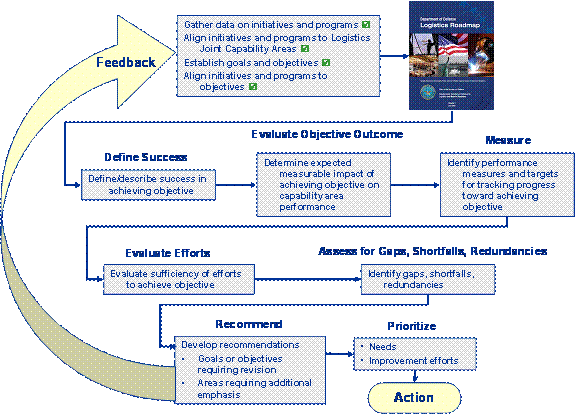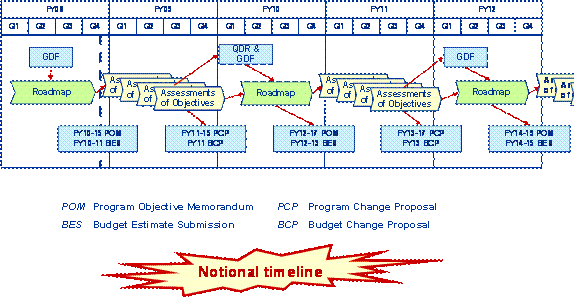What is the Roadmap?
What is the Purpose?
What is the Scope?
How is the Roadmap organized?
 DoD Logistics Roadmap signed on July 23, 2008 DoD Logistics Roadmap signed on July 23, 2008

Overview briefing
The Roadmap has two volumes:
Volume I establishes objectives to improve the capabilities and capacity of the Department’s logistics forces, links the objectives to specific logistics capability areas, and then assembles, integrates, and documents specific actions underway or planned to achieve the objectives.
Volume II provides additional details on the initiatives and programs of record identified in Volume I.
Distribution memo
 Initial assessments of Roadmap objectives are in progress Initial assessments of Roadmap objectives are in progress

Three Department-wide assessments currently being conducted at the request of the Deputy Under Secretary of Defense for Logistics and Materiel Readiness:
Defense Logistics Agency is leading the assessment of Objective 1.2 — Effective procurement processes. (Tasking memo)
The Office of the Assistant Deputy Under Secretary of Defense for Maintenance Policy and Programs is leading the assessment of Objective 3.3 — Identify and sustain requisite core maintenance capability. (Tasking memo)
USTRANSCOM is leading the assessment of Objective 2.3 — Visibility of in-transit, in-storage, and in-process units and materiel for optimized movement planning and execution. (Tasking memo)
What is the Roadmap?
The 2008 DoD Logistics Roadmap is a detailed depiction, over time, of the Department’s existing, planned, and desired logistics capabilities across the spectrum of doctrine, organization, training, materiel, leadership and education, personnel, and facilities (DOTMLPF). It flows from the logistics-related guidance in the National Security Strategy, National Defense Strategy, and National Military Strategy; the logistics-related strategic goals and objectives in the Quadrennial Defense Review (QDR) Report; the Deputy Secretary of Defense’s priorities for the Department; DoD’s logistics mission; and the logistics goals specified in the Department’s Guidance for the Development of the Force (GDF).
Building on the logistics goals from the GDF, the Roadmap establishes objectives to improve the capabilities and capacity of the Department’s logistics forces. It links the objectives to specific logistics capability areas. It assembles, integrates, and documents specific actions underway or planned to achieve the objectives. These include key initiatives and programs of record from the supply chain areas of DoD’s logistics capability portfolio.
The Roadmap is a first step in developing a more coherent and authoritative framework for guiding the Department’s logistics improvement efforts. It provides a foundation for future logistics capability assessments and investment analyses. Future editions of the Roadmap will report progress toward achieving logistics capability performance targets. They will incorporate results from DoD studies and analyses, capability-based assessments, joint experiments, and joint technology demonstrations. They will also connect capability performance targets to current and planned logistics investments for an overarching view of DoD’s progress toward improving logistics performance.
Figure 1 illustrates how the Roadmap is part of an ongoing process of assessment and feedback that is linked to the QDR and the Planning, Programming, Budgeting, and Execution (PPBE) cycles and that supports informed senior leader decision making in a constrained resource environment.
Figure 1. Roadmap Linked to Key DoD Decision Support Processes

The Roadmap will allow the Department’s senior leaders to more effectively advocate the logistics initiatives and programs most critical to providing globally responsive, operationally precise, and cost-effective logistics support for America’s warfighters
Back to top
What is the Purpose?
The DoD Logistics Roadmap serves a threefold purpose:
- It is a tool for the Department’s senior logistics leaders at all organizational levels—OSD, Combatant Command, Service, and defense agency—in guiding, measuring, and tracking progress toward achieving DoD logistics goals and objectives. Concurrently, it establishes a foundation for logistics capability portfolio management (CPM).
- It implements guidance from the Under Secretary of Defense for Acquisition, Technology, and Logistics (USD[AT&L]) to develop a more comprehensive roadmap to supersede the Focused Logistics Roadmap published in 2005.
- It subsumes the DoD Plan for Improvement in the GAO High Risk Area of Supply Chain Management with a Focus on Inventory Management and Distribution.
For more background information on Logistics CPM, the Focused Logistics Roadmap, and the DoD Plan for Improvement in the GAO High Risk Area of Supply Chain Management with a Focus on Inventory Management and Distribution, see Appendix A.
Back to top
What is the Scope?
The 2008 DoD Logistics Roadmap builds upon three broad GDF goals — unity of effort, visibility, and rapid and precise response.
The GDF directs the Department to focus on better integrating its logistics capabilities and processes to meet demands of an emerging operational environment. It also emphasizes the need to secure, enhance, and protect our global supply network en route infrastructure.
In alignment with the GDF, the Roadmap focuses on three logistics joint capability areas (JCAs) that comprise supply chain operations — supply, maintain, and deployment and distribution. For additional information on the logistics JCA lexicon, see Appendix B.
The Roadmap describes individual initiatives and programs in terms of expected benefits or impacts, milestones, and resources. It discusses performance measures for tracking progress in improving DoD logistics capabilities, capacity, effectiveness, and efficiency. It provides a basis for current and future capabilities assessment. However, it currently does not contain assessments at the initiative, program, JCA, or portfolio level. Assessments will be incorporated in future updates.
Back to top
How is the Roadmap organized?
The 2008 DoD Logistics Roadmap has two volumes. Volume I establishes objectives to improve the capabilities and capacity of the Department’s logistics forces; links the objectives to specific logistics capability areas; and then assembles, integrates, and documents specific actions underway or planned to achieve the objectives. Volume II provides additional details on the initiatives and programs of record identified in Volume I.
Volume I includes the following chapters:
- Chapter 2 states the DoD logistics mission and the GDF logistics goals. Building on the GDF goals, it establishes twenty two objectives to improve the capabilities and capacity of the Department’s logistics forces. It then links each objective to the JCA it primarily supports—five link principally to the Supply JCA, seven link principally to the Maintain JCA, and five link principally to the Deployment and Distribution JCA. In addition, five cross-cutting objectives strongly support all three JCAs.
- Chapter 3 examines the five cross-cutting, portfolio-wide objectives identified in Chapter 2. It includes GDF guidance concerning candidate capabilities for increased investment by USTRANSCOM (in its role as the DoD Distribution Owner), Services, and DLA. Each objective has a stand-alone section that describes ongoing initiatives and programs that support the objective. Initiative and program descriptions and data were provided by the sponsoring DoD Component (Combatant Command, Military Service, defense agency, or Office of the Secretary of Defense) in response to a data call issued by the Deputy Under Secretary of Defense for Logistics and Materiel Readiness (DUSD[L&MR]).
- Chapter 4 addresses the Supply JCA. It states the GDF guidance concerning supply operations, provides definitions for both the Tier 1 and Tier 2 capabilities in the Supply JCA, and discusses the five objectives that link principally to the Supply JCA. For each objective that primarily supports the Supply JCA, a stand-alone section describes ongoing initiatives and programs that support the objective. Initiative and program information were provided by the sponsoring DoD Component.
- Chapter 5 addresses the Maintain JCA. It states the GDF guidance concerning maintenance operations, provides definitions for both the Tier 1 and Tier 2 capabilities in the Maintain JCA, and discusses the seven objectives that link principally to the Maintain JCA. For each objective that primarily supports the Maintain JCA, a stand-alone section describes ongoing initiatives and programs that support the objective. Initiative and program descriptions and data were provided by the sponsoring DoD Component.
- Chapter 6 addresses the Deployment and Distribution JCA. It states the GDF guidance concerning deployment and distribution operations, provides definitions for both the Tier 1 and Tier 2 capabilities in the Deployment and Distribution JCA, and discusses the five objectives that link principally to the Deployment and Distribution JCA. For each objective that primarily supports the Deployment and Distribution JCA, a stand-alone section describes ongoing initiatives and programs that support the objective. Initiative and program descriptions and data were provided by the sponsoring DoD Component.
- Chapter 7 addresses the 2008 Roadmap’s evolving role in supporting DoD’s continuing shift to capabilities-based planning and governance reform for managing the Department increasingly by using joint capability portfolios. It explains how future roadmaps will have documented assessments to furnish logistics decision makers and associated logistics governance bodies with concise updates about the state of DoD logistics. Future roadmaps also will identify credible options and resource requirements for achieving high-priority logistics capabilities.
- Appendix A provides background information on three key factors that influence the direction, content, and scope of this Roadmap — the 2005 Focused Logistics Roadmap, implementation of Logistics Capability Portfolio Management, and the DoD Plan for Improvement in the GAO High Risk Area of Supply Chain Management with a Focus on Inventory Management and Distribution.
- Appendix B provides the Logistics Joint Capability Areas (JCA) lexicon.
- Appendix C lists all objectives, followed by the initiatives and programs that support them, sorted by organization.
- Appendix D lists the organizations that provided initiative and program data, followed by the initiatives and programs they submitted, and by the objectives that those initiatives and programs support.
- Appendix E provides references used in developing the Roadmap.
- Appendix F is a glossary of acronyms and key terms.
Volume II consists of the following appendices:
- Appendix G provides detailed descriptions of initiatives that improve the Department’s logistics capabilities.
- Appendix H provides detailed descriptions of programs of record that improve the Department’s logistics capabilities.
Back to top |